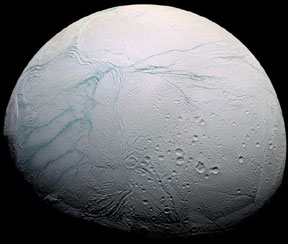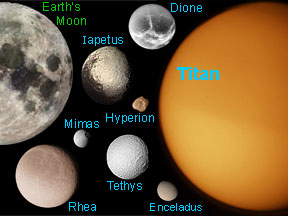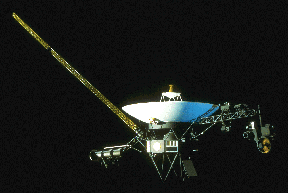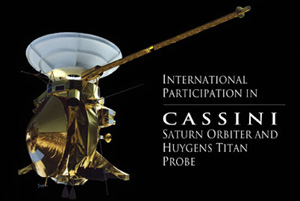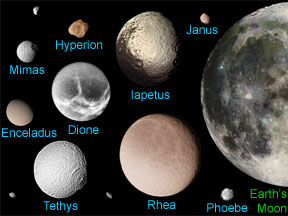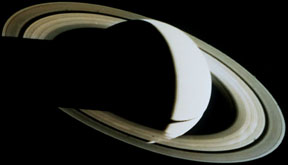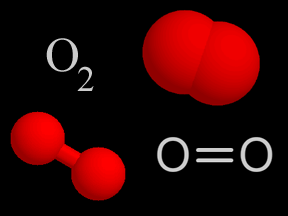Click on image for full size
Image courtesy NASA/JPL/Space Science Institute.
Enceladus
Enceladus is the sixth largest moon of Saturn. It was discovered in 1789 by the British astronomer William Herschel (who also discovered the planet Uranus). Enceladus is a medium-sized moon made primarily of ice. Its orbit is fairly close to Saturn and is within the giant planet's outermost ring (the E ring).
Although Enceladus can be viewed with Earth-based telescopes, most of what we know about the moon is the result of data collected by the Voyager and Cassini spacecraft. The bright surface of Enceladus is coated with water ice, making it the most reflective moon in our Solar System. Scientists have recently discovered plumes of ice crystals spewing from the moon's south polar regions, and are beginning to unlock the mysteries of the source of these plumes.
Much of the surface of Enceladus resembles the terrain on many of the Solar System's moons; a mixture of flat plains and impact craters. However, a large area around the moon's South Pole consists of a fractured landscape similar in appearance to that found on Jupiter's moon Europa. During a flyby in July 2005, instruments on Cassini detected temperatures in this region that were much higher than expected. One scientist remarked that "This is as astonishing as if we'd flown past Earth and found that Antarctica was warmer than the Sahara".
Some of the cracks in the midst of this fractured terrain are remarkably smooth and somewhat blue in color, and have been nicknamed "Tiger Stripes". These stripes appear to be much younger than most of the rest of the surface of the moon. Some scientists think that cracks in the moon's icy surface may be allowing liquid water from beneath the surface to spew forth in huge geysers. These geysers might be comparable to the famous ones found in Yellowstone Park on Earth, but would be much larger and much colder. Volcanic activity (including ice geysers or volcanoes, which are referred to as examples of "cryovolcanism") is very rare in our Solar System. Only Earth, Jupiter's moon Io, possibly Neptune's moon Triton, and now perhaps Enceladus have been observed to be volcanically active.
The ice plumes on Enceladus give the small moon a tenuous atmosphere. The atmosphere is uneven, being much denser near the moon's South Pole than on the other side. Because of the small moon's weak gravity, the atmosphere must constantly be replenished to replace molecules that are swept off into space. Enceladus' super-reflective surface is probably the result of it being coated by fresh ice particles from the plumes, just as a blanket of new fallen snow can make landscapes on Earth incredibly bright and reflective.
Enceladus was named after a giant from Greek mythology. He was one of the children of Gaia, and was amongst the giants who warred against the gods. He was defeated in battle by the goddess Athena, who buried him beneath the volcanic Mt. Etna. It was said that the fires from the volcano were the breath of Enceladus, a remarkable coincidence in light of the recent discoveries of possible cryovolcanism on the Saturnian moon. The names of geological features on the moon are derived from people and places mentioned in "The Arabian Nights".
Despite its giant namesake, Enceladus is a modest moon in size. Its diameter is around 505 km (314 miles), making it the sixth largest of Saturn's moons. Enceladus rotates once every 1.37 days. It orbits Saturn in exactly the same amount of time. This is not a coincidence. Many moons (including Earth's) have identical rotational and orbital periods, a phenomenon called "synchronous rotation". If a moon is fairly close to its parent planet, the gravity of the planet locks the periods of rotation and revolution together. Enceladus orbits Saturn at a relatively close distance of 238,040 km (147,911 miles), which is actually within the outermost ring (called the "E ring") of the planet's spectacular ring system.
Scientists believe that the ice particles that make up the E ring originate from Enceladus. They think that much of the ice emanating from Enceladus' southern polar regions escapes the moon's gravity and goes into orbit around Saturn, generating the planet's outermost ring! Furthermore, data from Cassini indicates that the Saturnian system is filled with oxygen atoms. Scientists postulate that as the water (H2O - hydrogen and oxygen) ice from Enceladus breaks down in space, it generates the observed oxygen atoms as well as hydrogen atoms. This claim is further supported by readings from Cassini's magnetometer instrument, which detected disruptions in Saturn's magnetic field in the neighborhood of Enceladus. Astronomers think ionized oxygen and hydrogen might be the cause of these disruptions.
Enceladus presents us with many mysteries. Are there reservoirs of water beneath the icy moon's surface, feeding the apparent ice geysers? If so, Enceladus may be of great interest to astrobiologists searching for life beyond Earth. The presence of liquid water seems a key ingredient for Earth-like life, so it's presence in other places fires the imaginations of astrobiologists. Enceladus may join its fellow Saturnian moon Titan, the planet Mars, and Jupiter's moons Europa and Ganymede (which may also have water beneath their icy shells) as prime targets in the search for extraterrestrial life.
Is there water beneath the surface of Enceladus, and, if so, why? What is making the moon's South Pole so warm, and why is the terrain there so fractured? Some scientists think that deposits of radioactive materials concentrated beneath Enceladus' pole may be heating the region and melting the ice. Others believe that stresses associated with changes in the moon's spin rate might have cracked the ice and helped create water, but don't yet know what might have caused the spin rate change. In any case, the little "giant" Enceladus has earned a place as one of the most intriguing bodies in our Solar System!


